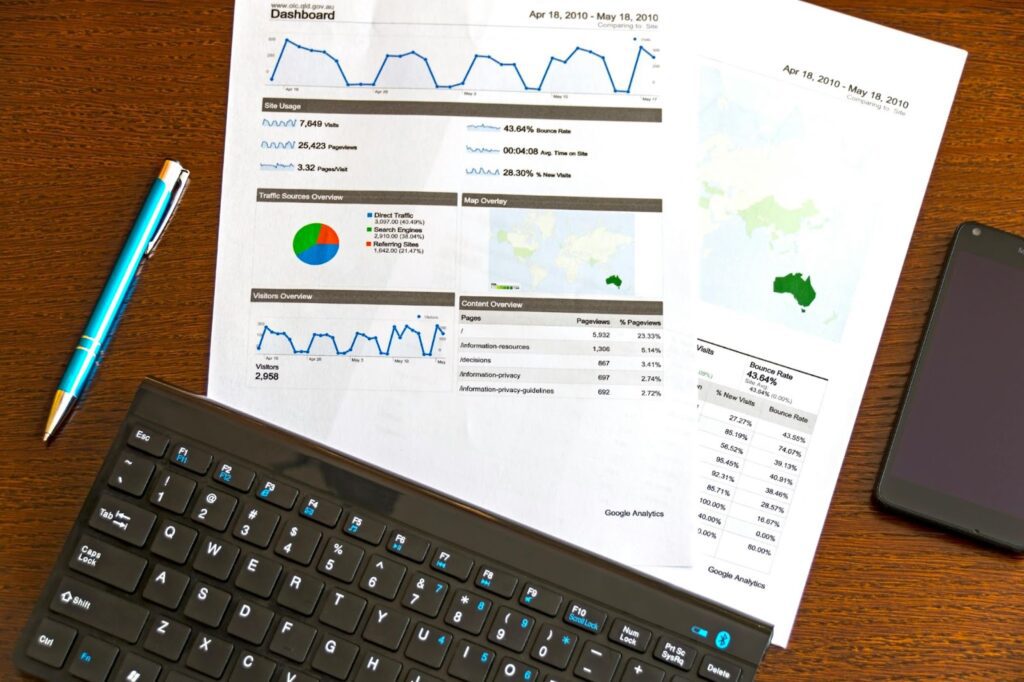Social media can sometimes feel like one of the most complex and commonly misunderstood platforms – do you have sky-high engagement but struggle to turn that interested audience into paying customers? Or does the performance of your paid ads feel hit-and-miss and hard to quantify?
The missing piece in your social media marketing strategy could be a well-structured social media marketing funnel. Let’s look at what this involves and how you can implement a high-converting funnel to improve your marketing efforts and drive tangible results.
Jump to Section
- What is a Social Media Marketing Funnel?
- Why Social Media Marketing Funnels are Key to Conversions
- 9 Steps to Develop a High-Converting Social Media Marketing Funnel
- 1. Define Clear Social Media Marketing Objectives
- 2. Develop Detailed Buyer Personas for Targeted Outreach
- 3. Segment Audience and Personalize Content for Each Group
- 4. Create Engaging Content Aligned with Each Funnel Stage
- 5. Select Platforms Where Your Audience is Most Active
- 6. Offer Valuable Resources to Capture and Nurture Leads
- 7. Create Optimized Landing Pages with Persuasive CTAs
- 8. Utilize Analytics Tools to Measure and Analyze Performance
- 9. Engage Leads with Targeted Follow-Up Campaigns
What is a Social Media Marketing Funnel?
A social media marketing funnel maps out each stage a customer goes through before making a purchase decision, looking at how your various social media activities influence them during each phase of their journey.
When we use the funnel and contextual targeting, we can better visualize and strategize how to move potential customers along each step of the way, from being unaware of your brand to the holy grail of becoming loyal brand advocates.
Why Social Media Marketing Funnels are Key to Conversions
Engages Audiences at Different Stages of Their Journey
Just like in business value streams, where each step is designed to maximize value delivery at that particular phase, your content must resonate with the audience’s level of awareness and engagement at the time. If it doesn’t, it’s likely to fall flat.
For example, using paid advertising to market offers to customers who are only just becoming aware of your brand potentially won’t get the results you’d want – they might not be ready to purchase. However, showing those same offers to loyal customers who have already engaged with your brand multiple times could lead to higher conversion rates.

Nurtures Leads with Value-Driven Interactions
A well-structured funnel nurtures leads through value-driven interactions. For instance, at the top of the funnel, a customer is just becoming aware of your brand, so this isn’t the time to hit them with a hard sell. Instead, you want to build familiarity with your brand and give them a reason to return and interact with you again.
For example, an IT consulting firm might publish an article titled “Understanding the Enterprise Architecture Framework,” where they explain what EA framework is and how it helps align IT with business goals. This educational content builds awareness of the company as a trusted advisor and encourages prospects to return for further information.
As they move further down the funnel, they might start to be more curious about how your company’s products or services can solve their problems. At this point, you could offer case studies, product demos, or webinars to provide more in-depth knowledge and demonstrate your expertise.
Optimizes Ad Spend for Effective Channel and Strategy Allocation
Looking at the different stages of the social media marketing funnel can help you to see which stages of the funnel are performing best, and which might need more attention. With this insight, you can identify where best to place your investment, or where you might be spending budget unnecessarily, ultimately optimizing your customer acquisition cost.
For instance, you might spot that Instagram is doing a great job of raising initial brand awareness at the top of the funnel, but you’re actually converting more customers on TikTok. With this in mind, you could concentrate your advertising spend on conversion-focused campaigns on TikTok.

Increases Conversions Through Multiple Touchpoints
A social media marketing funnel creates a number of touchpoints where potential customers can interact with your brand, subtly guiding them along their buying journey.
It starts when customers become aware of your brand through engaging content shared on various social media platforms, capturing their initial interest. Then, as they move into the consideration stage, you can share more detailed information and interact directly with them to build trust.
Finally, in the conversion stage, you can use a unified messaging platform for targeted ads and retargeting to remind customers about products they are interested in.
Implementing payment orchestration here ensures that the payment process is smooth and adaptable across various platforms, enhancing customer experience and potentially increasing conversion rates.
Key Stages of a Social Media Marketing Funnel
- Awareness: This stage focuses on getting the attention of prospective customers who may not yet be aware of your brand. Content should be aimed at creating awareness and establishing brand visibility on social platforms.
- Interest: Once they have been made aware of your product and brand, the next step is to intrigue potential customers about your offer. Here, you want to share valuable and engaging content with your target audience that resonates with their needs and interests.
- Consideration: Once they reach the consideration stage, potential customers are weighing up their various options. You want to share content that highlights the benefits of your product or service, provides social proof through customer reviews, and addresses common objections, to help convince them that you have the best solution.
- Conversion: This is when potential customers are prepared to make a purchase. Your content should be focused on prompting them to take action by making a purchase, signing up for a newsletter, or requesting a demo.
- Engagement: The funnel doesn’t end once you’ve turned a prospect into a customer. Loyal customers provide a reliable revenue stream, so post-purchase engagement is crucial. This stage is about communicating with customers, providing support, and encouraging repeat purchases.
- Advocacy: At the very bottom of the funnel, the aim is to convert satisfied customers into brand advocates. Here, you can drive word-of-mouth marketing by encouraging customers to share their positive experiences and refer others.

9 Steps to Develop a High-Converting Social Media Marketing Funnel
1. Define Clear Social Media Marketing Objectives
Clearly outline your objectives for your social media marketing efforts. Do you want to increase brand awareness? Perhaps you aim to drive sales or improve customer loyalty. Whatever your goal, decide what good looks like for you so you have something to measure success against.
2. Develop Detailed Buyer Personas for Targeted Outreach
You need to start with a good idea of who you are talking to and targeting at each stage, so build detailed buyer personas reflecting your ideal customers. This can include their demographics, interests, online behaviors, and pain points.
3. Segment Audience and Personalize Content for Each Group
With your buyer personas to hand, segment your audience based on their level of engagement, purchasing history, and interests. This allows you to personalize your content and interactions for each group.
You can take a look at account-based marketing examples to get ideas on creating highly personalized and targeted content for your various customer segments.
4. Create Engaging Content Aligned with Each Funnel Stage
From informative blog posts and catchy graphics at the awareness stage to product demos and testimonials at the consideration stage, everything you post should match up with the stage of the funnel your customer is at.
Mix up your formats to keep your audience engaged and include videos, infographics, or interactive posts.
5. Select Platforms Where Your Audience is Most Active
To avoid wasting your efforts on platforms where your potential customers aren’t active, research where your target audience spends most of their time online, and pay more attention to those platforms.
For example, Instagram ads might be the perfect place to market a new make-up brand, but if you want to sell your software solution to busy professionals, you’re better off heading over to LinkedIn.

6. Offer Valuable Resources to Capture and Nurture Leads
Everyone loves a freebie. Offering useful resources like ebooks, webinars, or templates in exchange for their contact details can be a great way to entice potential customers into the funnel.
Use these contact details to nurture them through the funnel with retargeting campaigns and email marketing.
7. Create Optimized Landing Pages with Persuasive CTAs
Have optimized landing pages ready so that when potential customers click through your social media ads or links, they are directed to something related to the content they clicked on.
Make sure the CTAs on these pages are persuasive enough to encourage visitors to take the desired action, be it signing up, downloading a resource, or making a purchase.
8. Utilize Analytics Tools to Measure and Analyze Performance
To make sure your funnel is working well, regularly track and analyze key metrics. By integrating business process transformation principles, you can use analytics tools to measure the levels of engagement, click-through rates, and conversion rates.
9. Engage Leads with Targeted Follow-Up Campaigns
Not every single lead will convert right out of the gate. For prospects who have shown interest but failed to take the next step, implement targeted follow-ups using personalized email marketing, retargeting ads, and social media messages to remind them about the value your brand brings and encourage them to move further down the funnel.
Conclusion
If you want to be truly successful on social media and turn your marketing efforts into conversions, then it takes a more strategic approach than just putting your content out there and hoping for the best.
A well-structured social media marketing funnel has the power to turn a casual follower into a loyal customer and advocate for your brand, driving long-term growth and success for your business.
This article is a guest post. The guest author is solely responsible for ensuring the accuracy and authenticity of the information provided in the article. Any product or service recommendations or mentions made in the guest post are not endorsed by Strike Social.
We invite you to contact us for guest posting opportunities. We are excited to collaborate with talented writers and feature high-quality content on our blogs.








